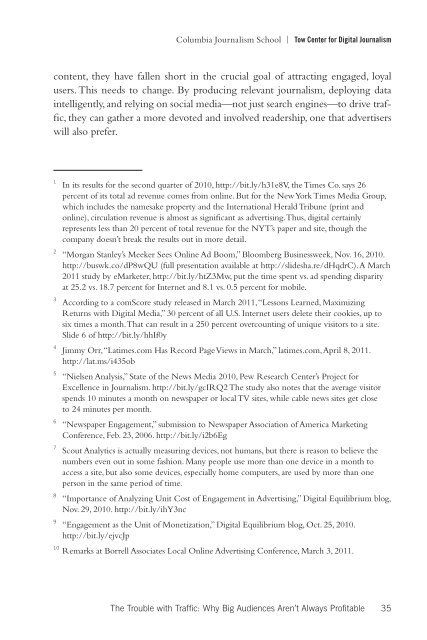What We Know About the Business of Digital Journalism
What We Know About the Business of Digital Journalism
What We Know About the Business of Digital Journalism
You also want an ePaper? Increase the reach of your titles
YUMPU automatically turns print PDFs into web optimized ePapers that Google loves.
Columbia <strong>Journalism</strong> School | Tow Center for <strong>Digital</strong> <strong>Journalism</strong>content, <strong>the</strong>y have fallen short in <strong>the</strong> crucial goal <strong>of</strong> attracting engaged, loyalusers. This needs to change. By producing relevant journalism, deploying dataintelligently, and relying on social media—not just search engines—to drive traffic,<strong>the</strong>y can ga<strong>the</strong>r a more devoted and involved readership, one that advertiserswill also prefer.1 In its results for <strong>the</strong> second quarter <strong>of</strong> 2010, http://bit.ly/h31e8V, <strong>the</strong> Times Co. says 26percent <strong>of</strong> its total ad revenue comes from online. But for <strong>the</strong> New York Times Media Group,which includes <strong>the</strong> namesake property and <strong>the</strong> International Herald Tribune (print andonline), circulation revenue is almost as significant as advertising. Thus, digital certainlyrepresents less than 20 percent <strong>of</strong> total revenue for <strong>the</strong> NYT’s paper and site, though <strong>the</strong>company doesn’t break <strong>the</strong> results out in more detail.2 “Morgan Stanley’s Meeker Sees Online Ad Boom,” Bloomberg <strong>Business</strong>week, Nov. 16, 2010.http://buswk.co/dP8wQU (full presentation available at http://slidesha.re/dHqdrC). A March2011 study by eMarketer, http://bit.ly/htZ3Mw, put <strong>the</strong> time spent vs. ad spending disparityat 25.2 vs. 18.7 percent for Internet and 8.1 vs. 0.5 percent for mobile.3 According to a comScore study released in March 2011, “Lessons Learned, MaximizingReturns with <strong>Digital</strong> Media,” 30 percent <strong>of</strong> all U.S. Internet users delete <strong>the</strong>ir cookies, up tosix times a month. That can result in a 250 percent overcounting <strong>of</strong> unique visitors to a site.Slide 6 <strong>of</strong> http://bit.ly/hhIf0y4 Jimmy Orr, “Latimes.com Has Record Page Views in March,” latimes.com, April 8, 2011.http://lat.ms/i435ob5 “Nielsen Analysis,” State <strong>of</strong> <strong>the</strong> News Media 2010, Pew Research Center’s Project forExcellence in <strong>Journalism</strong>. http://bit.ly/gcIRQ2 The study also notes that <strong>the</strong> average visitorspends 10 minutes a month on newspaper or local TV sites, while cable news sites get closeto 24 minutes per month.6 “Newspaper Engagement,” submission to Newspaper Association <strong>of</strong> America MarketingConference, Feb. 23, 2006. http://bit.ly/i2b6Eg7 Scout Analytics is actually measuring devices, not humans, but <strong>the</strong>re is reason to believe <strong>the</strong>numbers even out in some fashion. Many people use more than one device in a month toaccess a site, but also some devices, especially home computers, are used by more than oneperson in <strong>the</strong> same period <strong>of</strong> time.8 “Importance <strong>of</strong> Analyzing Unit Cost <strong>of</strong> Engagement in Advertising,” <strong>Digital</strong> Equilibrium blog,Nov. 29, 2010. http://bit.ly/ihY3nc9 “Engagement as <strong>the</strong> Unit <strong>of</strong> Monetization,” <strong>Digital</strong> Equilibrium blog, Oct. 25, 2010.http://bit.ly/ejvcJp10 Remarks at Borrell Associates Local Online Advertising Conference, March 3, 2011.The Trouble with Traffic: Why Big Audiences Aren’t Always Pr<strong>of</strong>itable 35
















